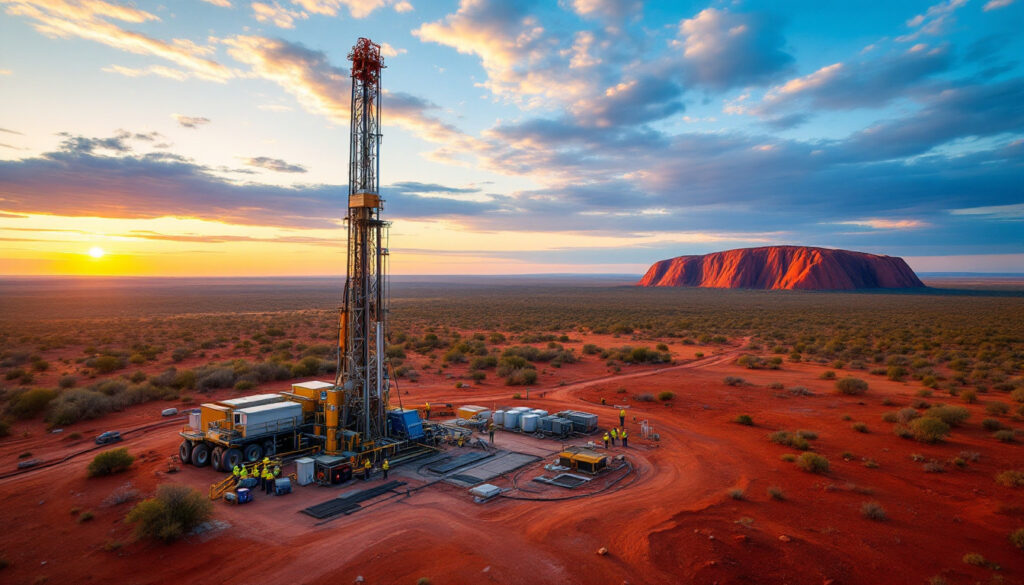Northern Territory's Exploration Initiative: Driving Resource Sector Growth
The Northern Territory Government has positioned itself as a driving force in Australia's resource sector, implementing a comprehensive strategy to stimulate mineral exploration throughout the territory. This initiative forms a crucial part of the government's broader economic rebuilding strategy, with Mining and Energy Minister Gerard Maley emphasizing that "a strong and competitive resources sector is key to creating jobs and driving economic growth across the Northern Territory."
The territory's geological diversity presents exceptional opportunities for resource companies, with vast untapped potential that could transform the NT into Australia's next major mining hub. Industry analysts suggest that the NT's mineral exploration sector could reach a valuation of $1.2 billion by 2030 if current investment trends continue.
What is the NT Government's Approach to Resource Exploration?
The Northern Territory Government has developed a multi-faceted approach to supporting mineral exploration as a strategic economic driver. Central to this strategy is the annual Geoscience Exploration Seminar (AGES) held in Alice Springs, which attracts hundreds of industry delegates eager to discover the Territory's mineral potential.
Dr. Ian Scrimgeour, Executive Director of the NT Geological Survey, notes that "AGES serves as both a scientific forum and investment showcase, highlighting the territory's extraordinary geological diversity and mineral potential."
The event functions as more than just a conference—it's a catalyst for investment, providing a platform where explorers, investors, and government officials can form partnerships that drive discovery. Previous AGES events have directly led to exploration programs that identified significant deposits, including the Rover 1 copper-gold project, which now holds an inferred resource of over 300,000 ounces of gold.
How is the NT Government Funding Exploration Activities?
Resourcing the Territory Program
The cornerstone of the NT's exploration strategy is the "Resourcing the Territory" program, backed by a substantial $9.5 million annual investment. This initiative delivers world-class geoscience data that helps companies reduce exploration risk and accelerate project timelines.
The program has proven remarkably effective, with a return on investment ratio of approximately 20:1 according to internal government assessments. For every dollar invested in pre-competitive geoscience data, approximately $20 in private exploration expenditure follows.
"The Resourcing the Territory initiative provides explorers with the foundational data they need to make informed decisions," explains Dr. Tania Dhu, Chief Geophysicist with the NT Geological Survey. "Our airborne electromagnetic surveys have identified several previously unknown conductors that likely represent sulfide bodies—potential hosts for copper, zinc, and other base metals."
Technical Support and Research
Beyond direct funding, the NT Government has established strategic collaborations with Geoscience Australia and leading research institutions. These partnerships enhance the territory's geoscientific capabilities and ensure that explorers have access to cutting-edge exploration methodologies.
Recent collaborative research has led to breakthroughs in understanding the territory's mineral systems, particularly in identifying pathways for mineralizing fluids in the Pine Creek Orogen. This knowledge is helping explorers target their drilling programs more precisely, resulting in a 22% improvement in discovery rates for companies utilizing these advanced datasets.
Which Geographic Areas Are Being Prioritized?
Northern Region Focus
The Pine Creek region stands as a priority area within the government's exploration strategy. With a rich mining history dating back to the 1870s gold rush, this region has produced over 4.5 million ounces of gold and substantial quantities of uranium, zinc, and other metals.
Recent geoscience work by the NT Geological Survey has identified several untested geophysical anomalies beneath shallow cover sequences. Magnetotelluric surveys have revealed potential sulfide systems at depths between 250-500 meters—targets that were previously undetectable with conventional exploration techniques.
Industry veteran and exploration geologist Dr. Sarah Montrose explains: "The Pine Creek region is geologically similar to Australia's Eastern Goldfields, but with significantly less modern exploration. The integration of new geophysical data with revised structural models has opened up targeting opportunities that simply didn't exist five years ago."
Central Australia Opportunities
While the Pine Creek region has captured significant attention, Central Australia presents equally compelling exploration opportunities. The government's balanced territorial approach ensures that promising areas throughout the NT receive appropriate focus.
The Arunta Region, spanning much of central Australia, hosts the Nolans rare earth deposit and shows potential for copper-gold systems similar to those found in South Australia's Olympic Dam province. Recent drilling has intersected copper grades exceeding 2.5% over significant intervals, suggesting the presence of substantial mineral systems.
Exploration campaigns in the Amadeus Basin have also yielded promising results, with helium concentrations as high as 6.2%—considerably higher than the 0.5% threshold typically considered economic. This finding positions the territory as a potential supplier to the global helium market, which faces critical supply constraints.
What Critical Minerals Are Being Targeted?
The NT Government has strategically aligned its exploration focus with global demand trends for critical minerals, recognizing their importance to emerging technologies and energy transition:
Lithium: The territory hosts several promising lithium prospects, including the Finniss Lithium Project, which has recently commenced production with a resource grade of 1.4% Li₂O—comparable to world-class deposits in Western Australia. Geoscientists have identified similar pegmatite fields across the Pine Creek Orogen that remain largely unexplored.
Graphite: Recent discoveries in the Arnhem Province have revealed high-grade graphite deposits with flake sizes ideal for battery anode material. Preliminary metallurgical testing indicates that these deposits can produce 99.95% pure graphite through standard processing methods, positioning the NT as a potential supplier to battery manufacturers.
Rare Earths: The Nolans project, developed by Arafura Rare Earths, represents one of the world's largest undeveloped rare earth deposits outside China. With a resource containing 56 million tonnes at 2.6% total rare earth oxides and critical neodymium-praseodymium grades of 0.7%, this project alone could supply up to 10% of global demand for these critical elements.
Dr. Kathryn Miles, Resource Economist at Northern Territory University, notes: "The territory's critical mineral endowment aligns perfectly with projected demand growth in electric vehicles and renewable energy. The NT has the potential to become a secure, ethical supplier of these materials to Western economies seeking to reduce dependency on Chinese sources."
What Are the NT Government's Strategic Economic Priorities?
The NT Government has outlined five strategic priorities that guide its economic development efforts, each with specific implications for the resource sector:
-
Be the best place to do business: The government has streamlined permitting processes, reducing approval timeframes by an average of 30% while maintaining rigorous environmental standards. A new online minerals titles system has cut administrative overhead for explorers by approximately 45%.
-
Build a bigger, better workforce: The Resource Ready program, launched in partnership with Charles Darwin University, offers specialized training in geoscience, drilling operations, and field techniques. This initiative aims to increase the local workforce participation rate in the mining sector from its current 62% to over 80% by 2030.
-
Deliver for Australia: The NT's critical minerals strategy directly supports national security objectives by developing domestic supply chains for strategic materials. Commonwealth co-funding for infrastructure has been secured to ensure these resources can reach global markets efficiently.
-
Unlock regional growth: Exploration activities generate significant economic benefits for remote communities. Data from the Department of Industry shows that exploration companies spend approximately 40% of their budgets locally, creating jobs and business opportunities in regional areas with limited economic diversity.
-
Connect the territory: Infrastructure improvements, including the upgrade of key transport corridors and expansion of digital connectivity in remote areas, are reducing operational costs for explorers by an estimated 15-20%.
Minister Maley summarized the government's vision: "We are committed to building an economy that is the manufacturing, mining and energy powerhouse of the nation, and benefits all Territorians by improving lives and restoring the territory lifestyle."
The Significance of Exploration for NT's Economic Future
Why is Resource Exploration Critical to NT's Economy?
Mineral exploration represents the essential first step in a value chain that can transform the Northern Territory's economic landscape. The government has designated 2025 as "a year of action, certainty, and security," recognizing that today's exploration investments lay the foundation for tomorrow's mines, jobs, and revenue streams.
Economic modeling by the NT Treasury indicates that for every 100 exploration projects, approximately seven advance to mine development, with each new mine generating an average of 350 direct jobs and contributing $145 million annually to the territory's economy. This multiplier effect extends beyond direct employment, with each mining job supporting approximately 3.5 additional positions in related industries.
Dr. James Hernandez, Resource Economist at the Australian National University, observes: "The NT's exploration strategy is particularly astute because it focuses on minerals essential to the energy transition. By targeting critical minerals like rare earths and battery metals, the territory is positioning itself to capture a disproportionate share of global exploration capital over the next decade."
How Does AGES Support the Exploration Sector?
Knowledge Sharing and Networking
The Annual Geoscience Exploration Seminar (AGES) serves as a crucial knowledge exchange platform, where government geologists present the latest findings directly to industry participants. This free flow of information reduces duplication of effort and allows companies to build upon collective knowledge rather than starting from scratch.
The event's structured networking sessions have proven particularly valuable, with post-event surveys indicating that approximately 35% of attendees form new business relationships or technical collaborations during the conference. Several junior explorers have secured farm-in agreements with major companies through connections established at previous AGES events.
Investment Attraction
AGES has established itself as a premier investment showcase for the territory's mineral potential. The 2023 event attracted over 30 institutional investors representing combined assets under management exceeding $120 billion. Following presentations, companies reported a 40% increase in investor inquiries and a 25% rise in trading volumes—tangible evidence of the event's impact on investment flows.
"AGES provides a unique opportunity to get all key stakeholders in one room—explorers, investors, regulators, and researchers," explains Samantha Li, Portfolio Manager at Pacific Resources Fund. "The technical quality of presentations is exceptional, allowing investors to make informed decisions based on solid geoscience rather than market hype."
What Makes the NT Attractive for Resource Exploration?
The Northern Territory offers explorers a compelling value proposition that combines geological potential with pragmatic government support:
Geological Potential: The territory encompasses six major geological provinces, each with distinct mineral endowment. The Pine Creek Orogen alone has produced minerals valued at over $30 billion in today's prices, yet modern exploration has covered less than 30% of its prospective area.
Government Support: Beyond the $9.5 million annual investment in pre-competitive geoscience, the government offers co-funding grants of up to $125,000 for greenfields drilling programs. Companies can recover up to 50% of direct drilling costs, significantly reducing the financial risk of testing conceptual targets.
Strategic Location: The territory's northern ports lie significantly closer to Asian markets than facilities in Western Australia or Queensland. The Darwin Port can reduce shipping times to Indonesian smelters by 4-5 days compared to Perth, translating to freight savings of approximately $8-12 per tonne.
Critical Minerals Focus: The NT hosts 13 of the 26 minerals classified as critical by the Australian Government, with particularly significant endowments of rare earths, lithium, cobalt, and vanadium. Global demand for these materials is projected to increase 400-600% by 2040, creating sustained market opportunities for NT producers.
Expert Insights on NT's Exploration Future
How Does the NT Position Itself in Australia's Mining Landscape?
The Northern Territory is deliberately positioning itself as "the manufacturing, mining and energy powerhouse of the nation" according to Minister Maley. This vision leverages the territory's unique advantages while addressing historical challenges that have limited development.
Unlike Western Australia's mature mining provinces or Queensland's coal-dominated sector, the NT offers explorers the rare combination of high geological potential and limited historical exploration. Only 18% of the territory has been subjected to systematic modern exploration techniques, compared to approximately 65% in Western Australia.
Professor Alexandra Chen, Economic Geologist at the University of Adelaide, notes: "The NT represents one of the last frontiers for major mineral discoveries in Australia. The geological setting is analogous to some of the world's most productive mineral provinces, but with a fraction of the exploration density."
What Challenges Must Be Addressed?
While the NT's exploration potential is undeniable, companies operating in the territory face several challenges that require strategic solutions:
Infrastructure Limitations: Many prospective areas lie 200-500 kilometers from existing transport networks. The Territory Infrastructure Fund has allocated $150 million specifically for resource-enabling projects, including all-weather access roads to high-priority exploration regions.
Seasonal Access Constraints: The northern regions experience intense wet seasons that can restrict ground access for 3-5 months annually. Companies are increasingly utilizing helicopter-supported programs and planning multi-year campaigns that concentrate field activities during the dry season while conducting data analysis during wet season downtime.
Indigenous Engagement: Approximately 50% of the NT is Aboriginal land requiring negotiated access agreements. The Aboriginal Areas Protection Authority has developed standardized exploration templates that reduce negotiation timeframes from an average of 14 months to less than 6 months while ensuring appropriate protections for sacred sites.
Environmental Management: The arid and tropical ecosystems of the NT require specialized rehabilitation techniques. The government's Environmental Bond Calculator now incorporates territory-specific factors, ensuring adequate financial provisions while recognizing the unique characteristics of NT environments.
FAQ: Northern Territory Exploration Initiatives
What is the Resourcing the Territory program?
The Resourcing the Territory program is a $9.5 million per annum government initiative designed to provide world-class geoscience data and support investment in the exploration sector. The program funds regional geophysical surveys, targeted drilling programs, and digital data integration to help companies identify prospective areas and reduce exploration risk.
Since its inception in 2018, the program has completed airborne magnetic surveys covering 220,000 square kilometers, approximately 15% of the territory's land area. These surveys have identified over 300 discrete magnetic anomalies, many of which represent potential mineral systems that were previously unknown.
Which critical minerals are being prioritized in the NT?
The NT Government is focusing particularly on lithium, graphite, and rare earths, recognizing their strategic importance to renewable energy technologies and advanced manufacturing. Current exploration activities have identified lithium-bearing pegmatites with grades exceeding 1.5% Li₂O across multiple regions, graphite deposits with carbon purity levels suitable for battery anodes, and rare earth accumulations with favorable distributions of high-value elements like neodymium and dysprosium.
Rare earths represent a particular focus, with the Nolans project containing an estimated 19% of the world's measured and indicated resources of neodymium and praseodymium outside China. These elements are essential for the manufacture of permanent magnets used in electric vehicles and wind turbines.
How is the NT Government supporting the mining sector?
Beyond exploration funding, the government has implemented several initiatives to support the broader mining sector:
- The Mining Remediation Fund, which allocates 1% of all security bonds to address legacy mine sites and improve environmental outcomes
- The Critical Minerals Virtual Data Room, providing investors with streamlined access to all available geoscientific data for priority commodities
- The Territory Resources Portal, a digital platform that reduces permitting complexity by guiding companies through regulatory requirements based on project specifics
- Royalty deferral options for development-stage projects, improving early-stage project economics without reducing long-term government returns
These initiatives collectively reduce the time from discovery to production by approximately 30% compared to historical timeframes, creating a significant competitive advantage for the territory. Additionally, the government's investment in mining feasibility insights helps companies make more informed decisions about project development.
What is the significance of the Pine Creek region?
The Pine Creek region represents one of Australia's most enduring mineral provinces, with continuous mining activity since the 1870s. Despite producing over 4.5 million ounces of gold, 270,000 tonnes of uranium oxide, and significant quantities of base metals, the region remains underexplored by modern standards.
Recent geological reinterpretations by the NT Geological Survey have identified at least three distinct mineralizing events spanning more than 500 million years of geological history. This multi-phase mineralization creates a complex but highly prospective setting where different commodity types can occur in close proximity.
The region's economic significance extends beyond its mineral endowment, with mining activities supporting approximately 12% of jobs in surrounding communities. Each active exploration program generates an estimated $450,000-$700,000 in local expenditure annually, providing critical economic diversity to areas traditionally dependent on agriculture and tourism.
The NT Government supports exploration by embracing digital transformation in mining and promoting the use of digital twins in mining to improve operational efficiency. Furthermore, strategic human capital investments are ensuring the territory has the skilled workforce needed to capitalize on mineral discoveries. Industry experts are already making mining industry predictions 2025 that indicate
Want to Be First to Hear About the Next Major Mineral Discovery?
Discovery Alert's proprietary Discovery IQ model delivers real-time alerts on significant ASX mineral discoveries, instantly empowering you to identify actionable opportunities ahead of the broader market. Visit https://discoveryalert.com.au/discoveries/ to see how major discoveries have generated substantial returns for early investors.




